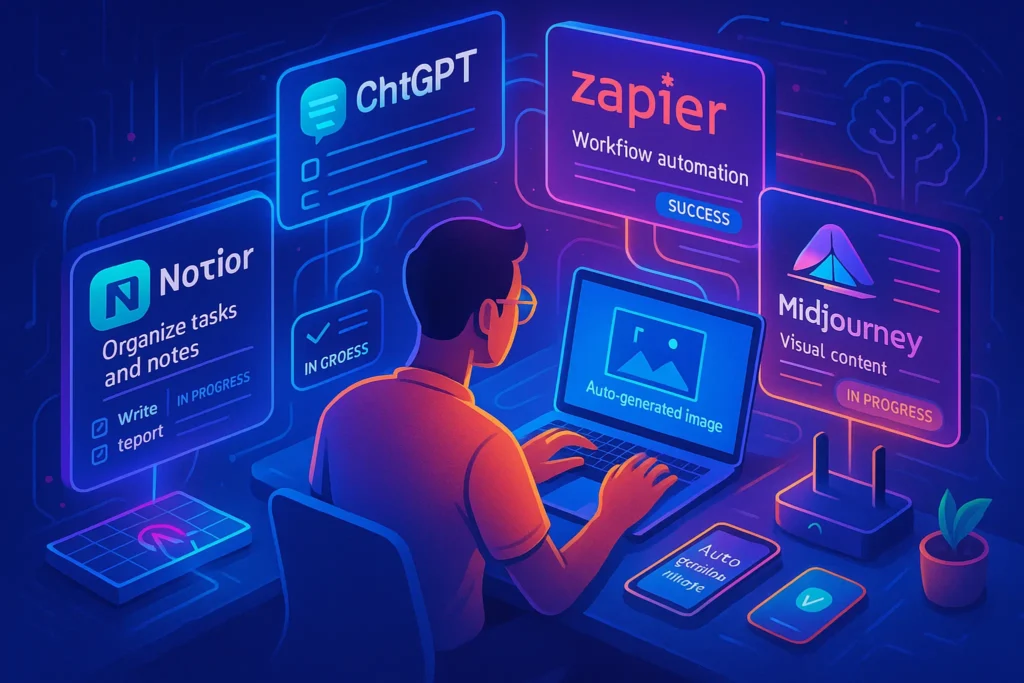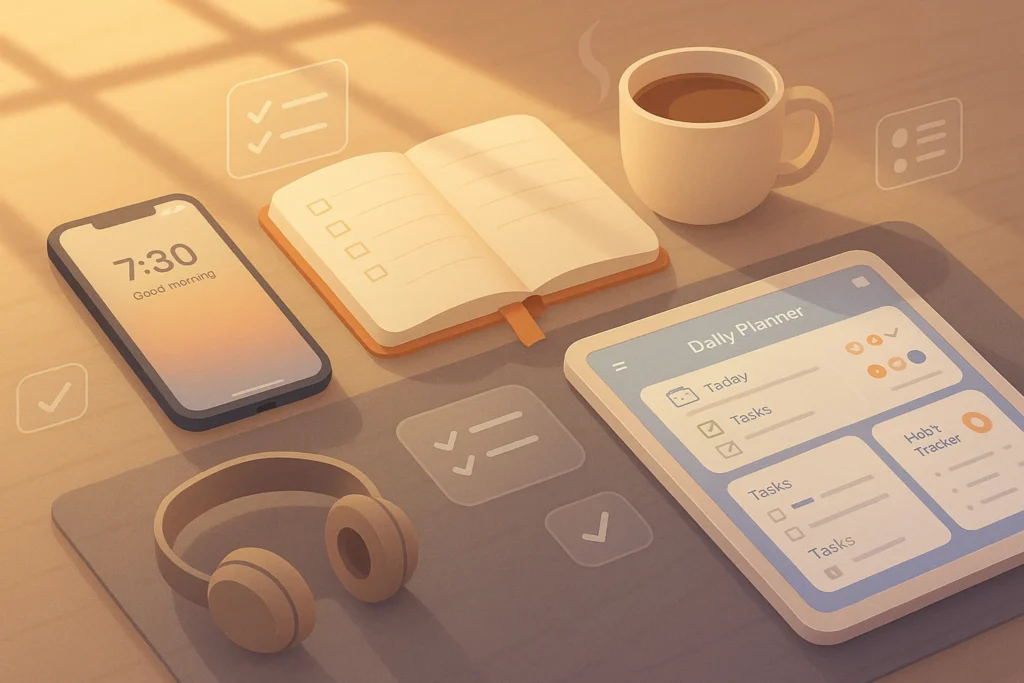🚀 Introduction: It’s Not About the Tools—It’s About How You Use Them
The AI boom has created a flood of new tools—planners, writers, chatbot builders, image generators, coders. But having access to powerful AI doesn’t guarantee results. In fact, most users barely scratch the surface of what these tools can actually do.
If you’re serious about using AI to save time, streamline work, or supercharge creativity, you need more than just logins and subscriptions. You need systems, habits, and techniques that actually make these tools work for you.
This post is a field guide for creators, solopreneurs, and productivity-minded professionals who want to go beyond basic usage. You’ll learn how to:
-
Design smarter prompts
-
Stack multiple AI tools for complex tasks
-
Balance automation with human judgment
-
Protect your data while leveraging AI at scale
Whether you’re already using ChatGPT or experimenting with tools like Notion AI, Midjourney, or Zapier, these pro tips will help you turn AI from novelty into a competitive edge.
✍️ Prompt Engineering 101: Better Questions, Better Results
At the heart of every AI tool is one key element: your prompt. Whether you’re asking ChatGPT to write a blog post or getting Midjourney to create a product mockup, how you ask makes all the difference.
A bad prompt = average output. A smart prompt = exponential results.
Here’s a simple before-and-after example:
❌ Basic Prompt:
“Write a product description for a phone case.”
✅ Optimized Prompt:
“Write a friendly, persuasive product description (120 words) for a biodegradable phone case designed for eco-conscious Gen Z users. Highlight sustainability and drop protection.”
Now you’re giving context, tone, target audience, and intent—all in one go.
🎯 Pro Tips for Prompting:
-
Use role instructions: “Act as a UX copywriter…”
-
Add format/length: “In 3 bullet points,” “Under 200 words”
-
Feed it examples or datasets for reference
-
Iterate: Let the AI try multiple variations before settling
This technique is especially vital when using advanced tools like ChatGPT for content creation or automating customer replies.
✅ Prompt Engineering: Before & After Comparison Table
Here’s how you can instantly upgrade your AI prompts—by adding structure, context, and intention.
| 🛠️ Task | ❌ Basic Prompt | ✅ Enhanced Prompt |
|---|---|---|
| Reply to customer | “Write a response to this complaint.” | “Write a polite, empathetic email to a customer complaining about delayed delivery. Keep it under 150 words.” |
| Brainstorm ideas | “Give me YouTube ideas.” | “List 10 viral video ideas for a productivity channel aimed at Gen Z freelancers using Notion.” |
| Summarize content | “Summarize this meeting.” | “Summarize the following Zoom call in bullet points. Focus on deadlines, decisions, and next steps.” |
| Create titles | “Write a blog title.” | “Write 5 SEO-friendly, click-worthy blog titles for a guide on AI-powered automation tools.” |
🧠 Nerd Tip: Save your best prompts in a swipe file and reuse them with slight variations. Prompting is a skill—practice makes powerful.
🧩 AI Tool Stack Integration: Build Your Own AI Workflow Engine
Using one AI tool is great—but combining several is where the magic happens.
Imagine this:
-
You use Notion AI to summarize meeting notes
-
Zapier detects new summaries and auto-sends them to a Slack channel
-
Meanwhile, ChatGPT drafts an action plan from that summary and stores it in Airtable
This is real-world AI orchestration—and it saves hours of manual work.
⚡ Power Combinations to Try:
-
Notion AI + Zapier + Slack → automate team updates
-
ChatGPT + Google Sheets + Email → automated reporting or outreach
-
Whimsical AI + Midjourney + Figma → concept > visuals > prototyping
This concept of stacking tools into a unified workflow is what powers most of the strategies we discussed in Best AI-Powered Workflow Automation Tools. The goal? Automate tasks, not just steps.
✅ How People Actually Use AI
Sometimes the best way to learn is to see how others are doing it. Here are three practical, real-world AI workflows used by professionals across different fields:
-
🧑🎨 Freelancer Designer
Uses ChatGPT to draft client proposals, Midjourney for concept visuals, and Zapier to automatically send project summaries to clients via Gmail. -
📈 Solo Startup Founder
Builds a lead-qualifying chatbot with Botpress + OpenAI API, logs hot leads into Notion CRM, and uses Notion AI to summarize weekly progress. -
🎙️ Content Creator / YouTuber
Scripts video outlines with Notion AI, writes titles with ChatGPT, records and edits with Descript, and repurposes clips with Opus Clip.
🔁 Want more ideas like these? Pair this with our post on Top 10 AI Tools for Business to build your own custom stack.
⚖️ Avoiding Over-Reliance: Find the Right Human–AI Balance
AI can be fast, smart, and tireless—but it’s not always right. Over-relying on automation can quietly erode creativity, introduce subtle errors, or make your brand sound robotic.
That’s why successful creators and teams build Human-AI feedback loops. They let AI handle the heavy lifting (drafting, formatting, suggesting), but retain control over tone, accuracy, and decision-making.
🤖 When to Use AI:
-
Drafting first versions
-
Brainstorming ideas
-
Reformatting or summarizing
🧠 When to Stay Human:
-
Final voice and tone checks
-
Strategic decisions
-
Sensitive communication (e.g. sales, HR, legal)
This philosophy aligns with what we explored in The Rise of AI CoPilots: AI should assist—not replace—you.
📬 Want Weekly AI Tips That Actually Save Time?
Join our free newsletter to get smart use cases, prompt templates, and productivity workflows with AI—delivered to your inbox.
No hype. Just useful tactics for creators, marketers, and solopreneurs.
🔐 100% privacy. No noise. Just actionable AI strategies from NerdChips.
🔐 Privacy & Data Awareness: Don’t Trade Speed for Security
AI tools can streamline everything, but they often require access to your inputs. If you’re not careful, you might expose sensitive data to open APIs, 3rd-party servers, or AI models trained on your content.
⚠️ Golden Rule: Don’t paste confidential data into tools you don’t fully control.
🔎 What to Watch For:
-
Public/free tools like ChatGPT or Bard don’t guarantee data deletion
-
Some browser extensions quietly log data for training
-
File uploads (PDFs, Excel) can be stored unless stated otherwise
🧠 Nerd Tips:
-
Use local/enterprise versions of AI where possible
-
Read privacy pages before using API-based tools
-
Anonymize sensitive inputs (names, numbers, client data)
-
Stay updated with terms of use—many change frequently
In our guide on How AI is Transforming Productivity, we stressed that trust is the new currency of AI adoption. Protect yours.
⚠️ Common AI Misuse to Avoid
- Blindly copying AI content without fact-checking
- Letting AI determine brand voice without human input
- Feeding confidential or personal data into public models
AI is a powerful tool—but only when used responsibly and intentionally.
🧩 AI Tool Stack Templates for Different Roles
Skip the guesswork. Here’s how real people combine AI tools to save time, stay sharp, and scale their output:
| Role | Stack |
|---|---|
| 🎓 Educator | Notion AI + ChatGPT + Tactiq (for meeting transcripts) |
| 🛍️ Marketer | Jasper + Surfer SEO + Zapier + MailerLite |
| 🎧 Podcaster | Descript + Whisper API + ChatGPT (for episode titles + summaries) |
| 📊 Data Analyst | Claude + Excel AI + Airtable + Make.com |
✨ Customize your own stack by combining tools covered in Best AI Workflow Automation Tools.
🧠 Nerd Verdict
AI isn’t magic—but when used intentionally, it feels like it. The real difference isn’t the tool you choose—it’s how well you design your inputs, combine your systems, and stay in control of your output.
The most productive professionals in 2025 don’t just use AI. They architect their workflow around it.
It’s not about replacing yourself.
It’s about augmenting yourself.
❓ FAQ: Nerds Ask, We Answer
💬 Would You Bite?
What’s one AI tool or workflow that completely changed how you work?
Or… what’s something you’re still struggling to automate?
Drop your favorite use case—or burning question—in the comments below 👇



